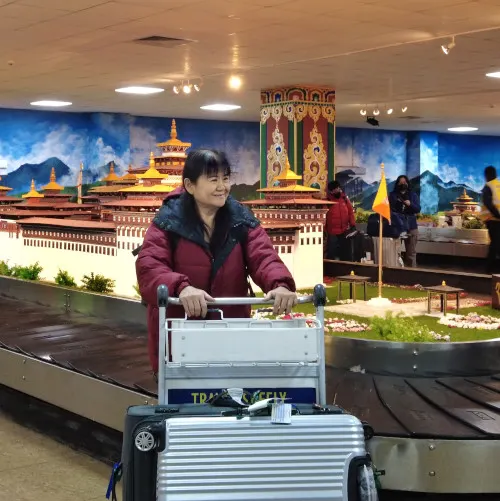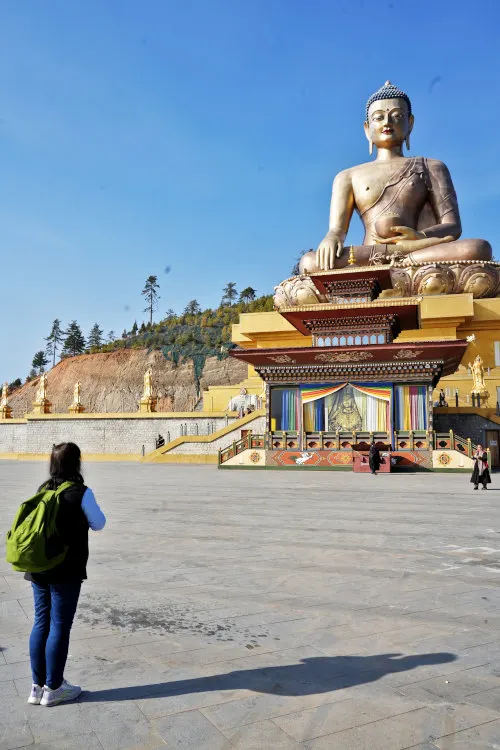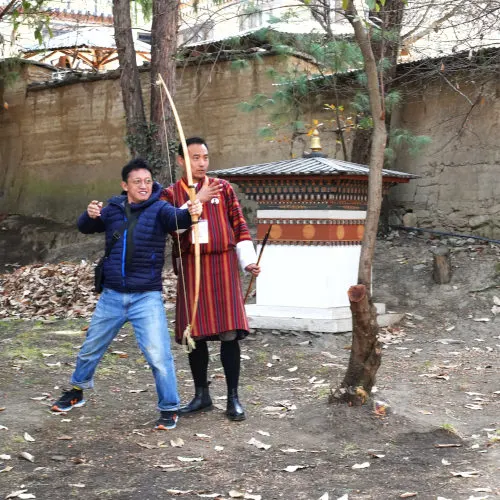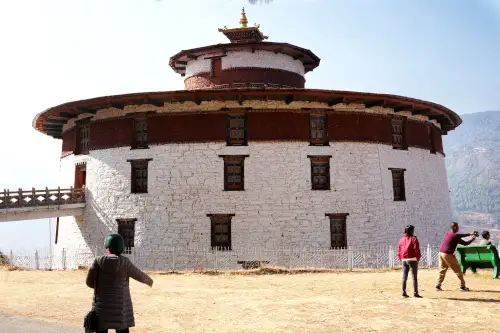
Are you looking for a Bhutan itinerary that gives you the details and images? We were just like many others tourists, attracted by the advertisements and brochures from the tour company, and wanted to visit this mysterious country.
However, the information is limited to a brochure, usually with only a few lines describing each destination. Some brochures might have several images but are far from the details we wanted.
After returning from Bhutan, we decided to write this article based on our Bhutan itinerary and expand each section so you can now have complete information about what you expect. We joined the tour from Malaysia, and it was a 6D4N package, the most popular Bhutan itinerary for most Malaysian. Of course, you may book your tour from other countries, but the information will be equally helpful as it covers Bhutan's three most important destinations- Paro, Thimphu, and Punakha.

Our Booking information
We booked our trip through Golden Tourworld Travel (M) Sdn Bhd. Since there is no scheduled flight from Malaysia to Bhutan, Travel Bhutan Tours has arranged charted flight directly from Kuala Lumpur to Bhutan by Bhutan Air. You need to make the necessary connecting flight if you are going from other countries. Only two airlines are operating their flight to the only international airport of Bhutan at Paro- Bhutan- Drukair and Bhutan Air.
Below is the detailed breakdown of our Bhutan itinerary. We have also written a few more articles at specific locations. You can click the links in the respective section to read the details.
Day 1- (Kuala Lumpur- Paro-Thimphu)
Our flight by Bhutan Air was scheduled to leave Kuala Lumpur at 4 am.

Our journey started as scheduled at 4 am. The flight took four hours and 20 minutes to reach Bhutan, 2 hours behind Kuala Lumpur.
1. Paro International Airport
Paro International Airport is one of the most dangerous airports in the world. There are only less than 20 pilots worldwide allowed to land here. The challenging landing is due to the high altitude, strong wind, and flight between Himalayan mountain ranges while descending at the deep Paro Valley.


In addition, the pilot must fly manually as the radar system is not usable here, and the short runway can be seen when the plane is only 200m away after a 45 degrees sharp turn.
Click here to read our article on Paro Airport, Bhutan.
After leaving Paro International Airport, we head straight to Olathang Hotel for breakfast. Our guide informed us that there was a change in our Bhutan itinerary. Instead of visiting places in Paro, we will head straight to Thimphu today.

We made a pit stop at the Gagyel Lhundrup Weaving Centre along the way.

After arriving at Thimphu, it was already lunchtime. We head to the Folk Heritage Restaurant to have our traditional Bhutanese lunch. This is the first traditional Bhutanese meal we have had. They served most traditional and well-known Britannese food such as Jasha maru (chicken stew), Kewa Dasi (Potato with cheese), Ema Dasi (chili and cheese), and suja tea (butter tea)


After lunch, we visited a few places in Thimphu as below:
2. Mothithang Takin Reserve

The Motithang Takin Preserve, located on the outskirts of Thimphu Valley in Bhutan, is a protected area dedicated to preserving the takin, the national animal of Bhutan.
Early in the 1970s, the Motithang Takin Preserve was founded to protect and conserve the takin. It was set up as a result of the King of Bhutan's decision to free the takins housed in a city's little zoo.
According to legend, the takin was created by the Divine Madman in the 15th century by combining a goat's skull and a cow's skeleton at the request of locals.
Scientifically, the takin is a unique breed of goat-antelope native to Bhutan. Takin is Bhutan's national animal known for its protruding nose, large head, and sturdy torso.

The preserve was originally a mini-zoo, but it went against Buddhist teachings to confine animals. As a result, all the animals were released into the wild.
Later, as takins were seen roaming the city streets searching for food, authorities established the Motithang Takin Preserve.
3. Changangkha Lhakhang

Changangkha Lhakhang is one of the oldest Buddhist temples in Thimphu,
The temple was established in the 12th century by the Buddhist master, Phajo Drugom Zhigpo, and is dedicated to Avalokiteshvara.
Changangkha Lhakhang is an important site for child blessings and naming ceremonies in Bhutan.

Expectant mothers often come to the temple to receive blessings for their unborn children. As for the new parents, they will bring their newborns to receive a blessing and to have their child's name chosen by a Buddhist lama. It also offers blessings to young students before they begin their studies.
4. National Memorial Chorten

The National Memorial Chorten (Thimphu Chorten) is a whitewashed Tibetan-style stupa in Thimphu.
It was built in 1974 to honor His Majesty Jigme Dorji Wangchuck, the third king of the Wangchuck Dynasty.
The design is in the traditional Bhutanese style known as "changchup chorten." It is characterized by its rounded dome, rectangular base, and intricate carvings and sculptures that adorn its surface. The chorten is surrounded by steps leading up to the entrance, symbolizing the path to enlightenment.

The National Memorial Chorten is both a Chorten and a chapel, allowing devotees to enter the ground floor.
5. Tashichho Dzong

Tashichho Dzong (Thimphu Dzong) is a majestic structure that features thirty temples, chapels, and shrines. It houses the throne room and offices of the king, the secretariat, and the ministries of home affairs and finance. Additionally, other government offices are located in nearby buildings.
The origins of Tashichho Dzong date back to 1216 when Lama Gyalwa Lhanangpa first constructed it in the location where Dechen Phodrang now stands above Thimphu. The present Dzong was rebuilt by the third king of Bhutan, Jigme Dorji Wangchuck, in 1962 after the capital of Bhutan was moved from Punakha to Thimphu. The entire structure was rebuilt without using any nails.
Only the central tower (utse), the new temple (Lhakhang Sarp), and the main protector temple (goenkhang) remained from the earlier Dzong.

The flag-lowering ceremony at Tashichho Dzong is a daily event that takes place at about 5 pm daily.
6. Night walk at Thimphu town
We checked in to the Taj Tashi hotel in Thimphu for two nights. It is a five-star hotel, a little surprise to most of us as we did not expect such a quality hotel in Thimphu.

The hotel is near the main street. We walked into the town and bought some souvenirs before we called it for the day.
Day 2 - (Thimphu-Punakha-Thimphu)
The first stop of our day two Bhutan itinerary is Dochula Pass.
1. Dochula Pass
We traveled from Thimphu to Punakha across Dolchula Pass, the highest highway point in Thimphu.

We departed at 8 am, and after 50 minutes of driving through some of the most beautiful landscapes and vegetation, we arrived at Dochula Pass.
We took pictures against the beautiful backdrop of the tranquil mountain vistas at Dochula Pass, then walked towards the most important monument, the Druk Wangyal Khang Zhang Chortens.

Dochula Pass in Bhutan is not the highest mountain pass in the world, but it unquestionably has one of the most stunning vistas of all mountain crossings. In addition, the 108 chortens tell a fascinating story about Bhutan's spirituality and history.
The pass lies close to Mt. Masanggang, Bhutan's highest peak at 23,000 feet, and rises to 10,000 feet above sea level.

The Himalayan mountain range can be seen clearly. It's a sunny day today. We witnessed some of the most breathtaking views of the snow-covered Himalayas and looked down into the Punakha Valley.
Other places that we visited on day two were mainly Punakha. Below are the places that we have visited in Punakha.
Click here to read our article on Dochulas Pass, Bhutan.
2. Kuruthang Temple

Next, we visited Kuruthang Temple in the Kuruthang village and attended a Monk Blessing Ceremony.

The ceremony typically involves chanting prayers and mantras and distributing sacred rice to be thrown when signaled. We were also offered holy water to drink and apply to our heads and faces. Lastly, we are given a golden string to wear on our necks.
3. Chimi Lhakhang

Chimi Lhakhang Temple is frequently visited by childless couples from the Punakha District and is well-known as the "Fertility Temple."

It is said that the temple can both bless child-bearing relationships and heal infertility. As part of the fertility blessings, women who wanted to get pregnant visited the temple and carried a wooden phallus around the building three times.
We climbed a short, dusty path through rows of prayer flags billowing in the wind. As we approach the summit of the mountain, we are greeted by a giant prayer wheel.

The main temple rises majestically in white. There is a sizable statue of Guru Rinpoche inside the Lhakhang. A statue of Lama Drukpa Kunley is situated next to him.
Click here to read our article on Chim Lhakhang, Bhutan.
4. Punakha Dzong

The Pungthang Dechen Phodrang, or "palace of tremendous delight or bliss," is another name for Punakha Dzong.
We entered the Dzong through a large wooden door and proceeded up a wooden staircase until we reached the outside courtyard.

It is also known for its magnificent buildings, which include four imposing entrances, seventeen temples, and breathtaking courtyards.
As opposed to the standard two courtyards, the Punakha Dzong contains three.

The administrative hub is located in the first courtyard, with a bodhi tree and a huge white Victory Chorten.
Monastic lodgings are only permitted in the middle courtyard. It houses the primary temple and quarters for the monks.

The Buddha and Guru Rinpoche are shown in gold sculptures in the main temple.
Its walls are decorated with exquisite paintings and woodwork. These murals show numerous moments from Guru Rinpoche's life, Bhutanese history, and mythology.

5. Returning trip to Thimphu

After visiting the Dzongs and Lhakhangs at Punakha, we headed back to Thimphu. Our tour bus crossed the Dochula Pass again during the golden hours.
Day 3 - (Thimphu-Paro)
After breakfast, we visited a few more places in Thimphu before returning to Paro.
1. Buddha point

On the fourth day of our journey to Bhutan, we went to Buddha Point. As one of the tallest Buddha sculptures in the world, standing 51.5 meters tall, it has become a must-visit tourist attraction in the Thimphu Valley.
The Buddha Dordenma statue was constructed on the ruins of Kuensel Phodrang, the palace of the thirteenth Druk Desi. It is situated at an elevation of 8711 feet and is visible from the city and the road we got there. The Buddha Point is another name for it because of its prominent location.

The monument is surrounded by a large platform providing a birds-eye perspective of the valley. There are 32 sculptures of the deities of offerings on the platform. They are all facing the Buddha and bearing various colorful offerings in their hands.

The statue's chamber is embellished with images of many gods, dragons, and other creatures. Buddha sculptures made of bronze can be seen in various positions. On the chamber's four walls are a total of 125,000 little bronze Buddha sculptures.
Click here to read our article on Buddha Point, Bhutan.
2. Folk Heritage Museum

The Folk Heritage Museum is a traditional Bhutanese farmhouse. There are three stories, with a traditional kitchen, living room, and bedrooms. There are also exhibits of household items, farm tools, textiles, and other artifacts used in daily life.

Outside the house features a demonstration of how to build the house the traditional way and the 150 years old grinding water mill.
A local lady also shows us traditional Bhutanese crafts, such as weaving.

We also tried the traditional Bhutanese archery at the open field outside the museum.
3. Jungshi Traditional Handmade Paper Factory

Our Bhutan itinerary also included visiting the Jungshi Traditional Handmade Paper Factory, established in 1991 to revive the traditional Bhutanese art of paper-making.
The paper is made from the Daphne plant's bark and processed by hand.
We have the opportunity to observe the process of making traditional Bhutanese paper, from soaking and processing the bark to forming and drying the sheets of paper.

There is also a souvenir shop next to the factory where you can purchase some souvenirs made with paper from the factory.
4. Bhutan Post Office Headquarters

Bhutan Post Office Headquarters is the only post office where you can create valid stamps with your image provided.

We purchased a few postcards to be sent back to our home addresses and friends with the special stamp featuring ourselves. This is a unique souvenir from Bhutan that you cannot get elsewhere.

We sent our chosen image to our tour agent before we came to Bhutan. As a result, our personalized stamps have been printed beforehand. The personnel at the post office can do it on the spot by transferring your image from your mobile.
5. Kira and Gho Photography session
Our tour agent has organized a Kira and Gho photography session at Le Meridian Hotel, Paro, in the afternoon.

A gho is a knee-length robe fastened at the waist with a "kera" belt made of fabric. It is worn with thick ankle-high socks and a light undershirt.

Women wear long, ankle-length dresses called kira. It is made with heavy woven fabric with exquisite patterning and is worn with an inner layer and a light shirt. The "koma," a huge metal or bone brooch, holds Kira at the shoulder.
These outfits are often worn in Bhutan, especially in rural regions and during formal events.

We went to bed earlier, as we had to wake up at 4:00 am tomorrow to prepare for our hike to the Tiger's Nest Monastery.
Day 4 -(Tiger's Nest Monastery)

Today is the most anticipated event in our Bhutan itinerary- visiting the Tiger's Nest Monastery. We got up earlier to arrive at the trailhead of Tiger's Nest Monastery by 7.30 am.
On average, four to five hours are often needed for the return trek, plus an extra hour for the monastery visit.
Instead of walking the entire trek, several opted to ride horses uphill until the halfway point.

The hiking route is relatively wide. At specific locations, it split into two paths: one for the horses and the other for us to hike. There are steps throughout most portions, making walking reasonably simple.
Due to the trail's proximity to a cliff, the stunning view of the mountain ranges and the Paro Valley can be seen clearly.

It took us around 1.5 hours to ascend to the café, which is about halfway up. We made several stops to snap pictures in different places.
Midway along the route, things start to level off. At the Taktsang Cafeteria, you may offer prayers and take a break from your hike to the Tiger's Nest Monastery.

After the café, the trail is steeper than previously. There are fewer steps, turns more rocky and rough.
Getting to Tiger's Nest Monastery from the café required another 45 minutes of trekking.
When we arrived at the Tiger's Nest Monastery, we had to leave behind our shoes, bags, cameras, and cell phones.

Besides that, photography is prohibited inside the monastery.
After dinner, we had to pack our luggage since we will check out early tomorrow. Our plan was to head straight to the airport after the half-day tour on the next day.
Click here to read our article on Tiger Nest Monastery.
Day 5 - (Paro-Kuala Lumpur)
Day 5 of our Bhutan itinerary was to visit all the remaining places as planned in Paro. Below are the places we visited.
1. Kyichu Lhakhang

Kyichu Lhakhang is one of Bhutan's oldest and most sacred temples, built in the 7th century.
According to the legend, Tibetan King Songtsen Gampo pinned down an ogress known as Demchok, who caused trouble and hindered the spread of Buddhism in the region. He used his spiritual powers to subdue Demchok and pin her down by building 108 temples. One of the temples is believed to be the Kyichu Lhakhang temple. Other temples were constructed in different parts of the Tibetan Empire, including Bhutan, present-day Nepal, and India, to pin down various parts of the ogress.

The murals and frescoes on the walls of Kyichu Lhakhang depicted the life of the Buddha, and various Buddhist deities, including bodhisattvas, dakinis, protectors, and Tantric practices.
The original temple was built in the 7th century by King Songtsen Gampo. It contains the original sanctum, which houses a statue of Guru Rinpoche and other religious artifacts.
In the 1970s, a new temple section was built to accommodate the growing number of visitors and provide additional space for religious ceremonies and festivals.

There is an old orange tree in the courtyard. According to local legend, the tree was planted by Guru Rinpoche himself when he visited the temple during his travels in Bhutan. It has the power to grant wishes and bring good fortune. If a person picks an orange after it drops from the tree and offers it to the statue of Guru Rinpoche, their wishes will be granted.
2. Rinpung Dzong

After visiting Kyichu Lhakhang, our next destination is Rinpung Dzong.
Rinpung Dzong is also called Paro Dzong. It is a large Dzong that serves as Paro's administrative and religious center.
Rinpung Dzong was damaged by fire in 1907. It was then renovated during the 1950s and 1960s, with added modern facilities such as electricity and heating.

It has two main sections. The Utse is the tallest tower that serves as the main entrance. The Goenkhang on the ground floor is dedicated to the guardian deities of Bhutan.
The exterior of Rinpung Dzong is decorated with intricate carvings and paintings. The walls are made of stone and are painted in white, red, and ochre colors.

There is a magnificent view from here overlooking the Paro Valley and part of the runway of the Paro International Airport.
3. Paro National Muzeum

The National Museum of Bhutan, also known as Ta Dzong, is the final destination in our Bhutan itinerary.
It was originally built in 1649 as a watchtower. Subsequently, La Ngoenpa Tenzin Drukdra, Paro's first governor, converted it to Paro Ta Dzong.
Initially, the building served as the residents of regional administrators and a storehouse that would ensure supplies in the event of warfare.
We must leave our bags and cameras in the locker in front of the museum. We cannot provide images since photography is not allowed inside the museum.

Stone adzes, earthen potsherds, and stone vessels are some of the artifacts in the exhibition meant to take visitors virtually back in time.
The open area outside the museum has a magnificent view of the whole Paro Valley.

We arrived at the airport after lunch. The return flight took slightly longer as we had an hour's layoff at Kolkata.
Click here to read our article "20 Things to know before your trip to Bhutan: A comprehensive guide.
Day 6 - (Kuala Lumpur)
We arrived at KLIA Airport after midnight, the 6th day of our trip! (So, as the brochure said, it is a 6D4N Bhutan itinerary!)
Our journey to Bhutan was a tapestry of memories, stories, excitement, precious moments, and friendship. All these experiences are interweaving together that will live in our hearts forever.
As we embark on this journey, we are filled with anticipation and a sense of adventure. Our Bhutan itinerary has brought us to Bhutan's most breathtaking and awe-inspiring sights.
This article will give you a clear understanding of what to expect from a standard Bhutan itinerary. Here is the information if you want to visit Bhutan:
- Our tour agent: Golden Tourworld Travel (Note: It is a tour company in Malaysia)
- For international travelers: Travel Bhutan Tours
Watch our video shot during our trip in Bhutan. 👇👇
If you have read this blog post this far, don’t miss out on the video shot during our trip to Bhutan. Click the image below to watch on YouTube (shot in high definition!).

Check out other articles related to Bhutan on this blog
- Buddha Point in Bhutan– One of the largest Buddha statues in the world
- Dochula Pass– The highest mountain pass in Bhutan with a spectacular view
- The complete guide to hiking to the Tiger’s Nest, Bhutan

vnie
Friday 9th of June 2023
can I know u travel on which season? and how much for the trip?
Ambiga Chelliah
Thursday 9th of November 2023
@kwankp, Hi, How was the flight from Kuala Lumpur? Is it from KLIA?
kwankp
Sunday 11th of June 2023
My trip was in January, and the price might have increased. It should be around Malaysian Ringgit 12K now for 6 nights 8 days, but please validate with your agent.